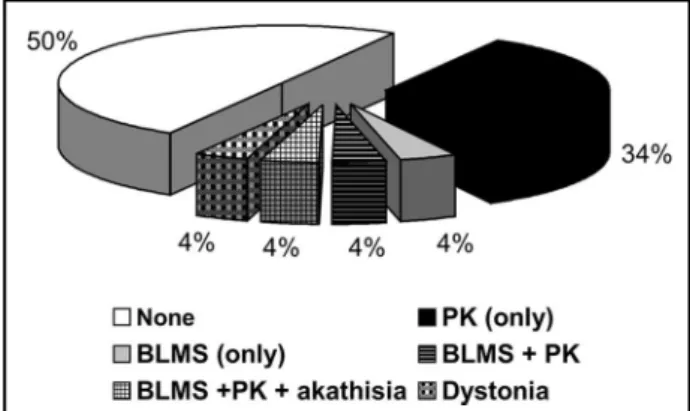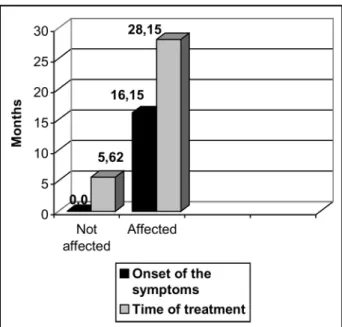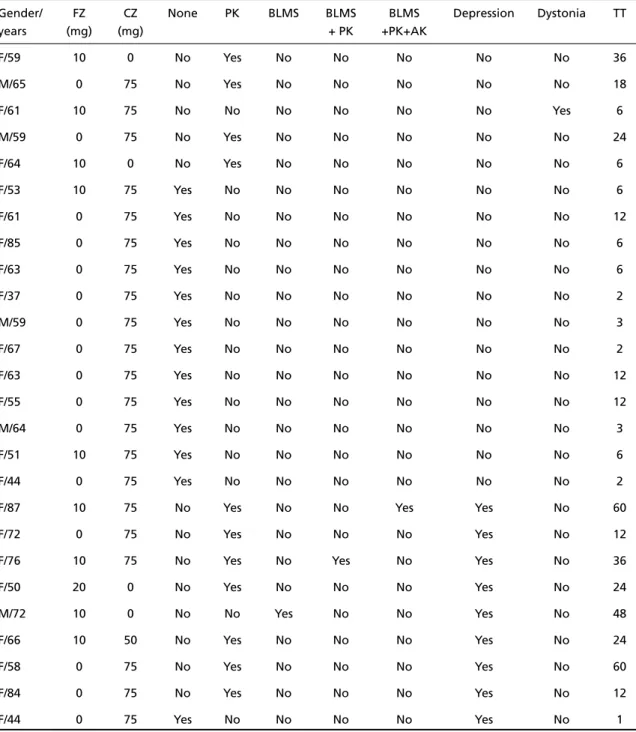1Clinical Neurologist at NEUROVITA - Hospital VITA de Curitiba, PR, Brazil; 2Assistant Professor of Internal Medicine, Faculdade Evangélica de Medicina do Paraná, Curitiba PR, Brasil (FEMPAR); 3Medical student at FEMPAR.
Received 24 November 2003, received in final form 25 March 2004. Accepted 14 May 2004.
Dr. Giorgio Fabiani - Rua José de Alencar 1307/53 - 80040-070 Curitiba PR - Brasil. E-mail: giorgiofabiani@aol.com
PARKINSONISM AND OTHER MOVEMENT
DISORDERS IN OUTPATIENTS IN CHRONIC
USE OF CINNARIZINE AND FLUNARIZINE
Giorgio Fabiani
1, Paulo C. Pastro
2, Carolina Froehner
3ABSTRACT - The purpose of this study is to determine the prevalence and the patterns of movement dis-orders (MD) in outpatients submitted to the chronic use of cinnarizine (cz) or flunarizine (fz), and to estab-lish the main risk factors for MD development. Over a period of 3 months, data were collected from out-patients who were chronic users of cz or fz in a municipal health institute. A total of 26 outout-patients were included and all of them were submitted to a protocol that included DSM-4 diagnosis criteria for drug-induced movement disorders, parkinsonism (PK) and depression. Parkinsonism was diagnosed in 34% of the patients, PK plus akathisia, PK plus akathisia and bucco-linguo-masticatory syndrome (BLMS), isolated BLMS and dystonia were found in 4% patients each. Patients with BLMS had the highest median age and the longest average period in which they used the drugs. The affected group, when compared to the non-affected one, presented with higher rates of depression. This study demonstrates the existence of a direct relationship between the time of use of cz and fz, the age and the prevalence of PK and other MD. It also suggests that these drugs increase the incidence of depression.
KEY WORDS: parkinsonism, drug-induced movement disorders, cinnarizine, flunarizine.
Parkinsonismo e outros distúrbios do movimento em pacientes ambulatoriais sob uso crônico de cinarizina ou flunarizina
RESUMO - O objetivo deste estudo foi determinar a prevalência e os padrões de distúrbios do movimen-to (DM) em pacientes ambulamovimen-toriais sob uso crônico de cinarizina (cz) ou flunarizina (fz), além de estabe-lecer os principais fatores de risco para o seu aparecimento. Durante três meses foram coletados dados de pacientes ambulatoriais em uso de cz ou fz. Todos esses pacientes foram submetidos a protocolo pré-esta-belecido que incluía critérios diagnósticos do DSM-IV para distúrbios do movimento induzido por drogas e critérios para diagnostico de depressão maior. Parkinsonismo (PK) puro foi diagnosticado em 34% dos pacientes, PK com acatisia, PK com acatisia e síndrome mastigatória bucolingual (SMBL), SMBL isoladamente e distonia, foram encontrados em 4% dos pacientes. Os pacientes com SMBL apresentavam a média de idade mais avançada, o maior tempo médio de uso das drogas, configurando-se o grupo de maior risco ao aparecimento dos DM. O grupo dos pacientes com DM apresentou maior incidência de depressão quan-do comparaquan-dos com os não afetaquan-dos. O estuquan-do demonstra uma relação direta entre o tempo de uso da droga, a idade avançada do paciente e o surgimento dos DM. Os resultados também sugerem que estas drogas aumentam a incidência de depressão.
PALAVRAS-CHAVE: parkinsonismo, distúrbios do movimento induzido por drogas, cinarizina, flunarizina.
Drug - induced parkinsonism (DIP) is the most com-mon cause of symptomatic parkinsonism (PK)1-3. It
can be caused by any drug that inhibits dopamine metabolism1-3. Neuroleptic drugs are the
best-re-cognized offending agents2. Cinnarizine (CZ) and
flunarizine (FZ) represent one of the most common causes of DIP in many countries where they are pres-cribed1-6. Melo-Souza first reported the occurrence
of PK and depression secondary to fz3. Afterwards,
Martí-Massó and Chouza, in addition to many
oth-ers, have reported patients with PK, tardive dysk-inesia, akathisia and depression induced by fz or cz4-10. Cinnarizine is a selective calcium entry
chan-nel blocker and is also neuroleptic - simile, and has antihistaminic, antiserotoninergic and antidopa-minergic activity. Flunarizine is a di-fluorinated derivative of cz, being 2.5 to 15 times more potent than2,5. Both cz drugs are widely prescribed for
Ame-rica1,2,4-10. Gimenez-Roldaan demonstrated
cinnar-izine-induced parkinsonism after a mean exposu-re of 4 (± 4) years6. Careful epidemiologic data are
still lacking. Some patients while using these drugs develop many side effects, including drowsiness, asthenia, depression and extrapyramidal side effects or movement disorders (MD) such as PK, dystonia, akathisia, and tardive dyskinesia. Depression is a ve-ry common side effect of these drugs1-6,8-10. The
pa-thophysiologic mechanisms underlying fz/cz indu-ced movement disorders remain uncertain, but the most likely is their ability to block D2-receptors, like many neuroleptic drugs2,5,7,11,12. There is also the
potential contribution of pre-existing basal ganglia dysfunction due to aging and vascular disease1,2,6,7,11.
The genetic risk-factors should not be ignored13.
This study aimed to determine the prevalence and the patterns of parkinsonism and other move-ment disorders, in addition to establish the depres-sion rates in outpatients submitted to chronic use of cinnarizine or flunarizine, and to establish the main risk factors for its development, correlating them with the results found in the literature.
METHOD
A retrospective study (point prevalence study) was performed at a municipal health-institute in the course of 3 months; we evaluated 26 outpatients that were tak-ing, for any reason, cz or fz, and complied with the in-clusion criteria.
The inclusion criteria were: to have been using cz or fz for at least one month; onset of the symptoms of PK/ MD (if applicable) after the beginning of the therapy with these drugs.
The exclusion criteria were: patients simultaneous-ly using other drugs that may be responsible for the de-velopment of the MD; patients using the drugs for less than one month; presence of any other factor that can explain the MD.
The MD were diagnosed and classified according to our pre-established protocol based on the diagnosis cri-teria established in DSM-IV for drug-induced movement disorders (including the tardive syndromes), drug-induced parkinsonism, and depression14. The protocol included questions about past history of essential tremor and PK, in the patient and family. All the patients were also submitted to the Hoehn-Yahr and Simpson Angus Scale (SAS) for rating the severity of the PK/MD15,16.
All the patients gave a verbal consent to participate in this study. The study was approved and authorized by the Araucaria Municipal Health Council. We only col-lected data from outpatients that were already using the-se drugs and we neither started nor induced the uthe-se of any of the drugs by any of them.
RESULTS
We evaluated 26 outpatients, most of whom we-re female, totalizing 21 patients or 81%, and only 5 patients or 19% were males. Regarding the diag-nosis of the movement disorders, we found 13 pa-tients to be completely normal or 50% of the sam-ple, 9 patients met the diagnosis criteria for parkin-sonism; one patient reported bucco-linguo- mas-ticatory syndrome (BLMS) plus PK; one reported BLMS plus PK and akathisia, one reported BLMS only and one reported dystonia. The data are sum-marized on Figure 1. The mean age of our sample was 62.3 years (57.4 years for the affected group and 67.2 years for the non-affected one). Figure 2 shows the mean time of use of the drugs prior to the onset of the symptoms and the mean time of the treatment (in months). The mean scores found in the SAS were 11.1 for the patients with PK and the Hoehn and Yahr scale’s mean score was 2.3 for the affected patients. None of the patients report-ed a past history of essential tremor or previous dia-gnosis of PK. Likewise, none of the patients, except for one with drug-induced parkinsonism, report-ed a positive familial history of PK; this is strictly dif-ferent from the most important study6. Nine
pa-tients met the DSM-IV diagnosis criteria for major depression. Most of them, 7 patients or 77.8%, re-ported its occurrence simultaneously with PK alone or in association with BLMS plus akathisia, or with BLMS as it occurred in one patient. The average doses of cz or fz the affected patients were using were 72.1 mg of cinnarizine and 11,2 mg of flu-narizine.
All the patients with BLMS were women and we-re diagnosed to be suffering with depwe-ression. They also had the highest mean age, with an average of 78.3 years, and also reported the longest time on drug use, with an average of 48 months. The most important data from this group of patients
are summarized on Table 1. On Table 2, the main data from all the patients of this study have been summarized. All the patients studied were using the drugs longer than six months.
DISCUSSION
Drug induced movement disorders (DIMD) are often unnoticed by general practitioners, mainly when they do not occur as a result of the use of dopaminergic blockers or neuroleptic drugs. The MD resulting from the chronic use of cinnarizine and flunarizine develop slowly and non-neurolo-gists do not pay much attention to their side effects. Many widely prescribed drugs can also be responsi-ble for or may be responsiresponsi-ble for the DIMD2,7,11,17.
Among the most common ones we can mention the antiemetics, drugs for dizziness (calcium
chan-nel blockers) and the neuroleptic drugs1,2,5,7-9,17.
Neu-roleptics can induce a variety of MD due to chan-ges in the dopaminergic pathways and it is the se-cond most frequent cause of parkinsonism7,17,18.
The pathophysiology of these disorders is almost always related to disturbances in the dopamine pa-thways, mainly by blocking the D2-receptors, like many neuroleptic drugs1,2,4,5,7,11,19. Brucke et al.
de-monstrated that studying patients examined with single-photon emission tomography using {123} iodobenzamide as a ligand and it showed the D2 receptor blockade by cz and fz19. Both drugs also
inhibit the Mg ATP-dependent generation of a transmembrane proton electrochemical gradients in chromaffin granule ghosts, reduce 3H-spiperone binding to bovine striatal membranes and 3H-dopamine uptake. An idiosyncratic vulnerability or hypersensitivity may also play a contributory role. Likewise, the genetic risk factors should not be ig-nored2,5-7,11,13. It is possible to start a sub-clinical PK
while any of these drugs is being used2. Young
pa-tients show a tendency to acute reactions, main-ly the dystonic ones; older patients, on the contrary, more often show tardive or chronic reactions. Par-kinsonism is by far the most common MD encoun-tered in these patients. There is an increased risk for women to develop drug-induced PK and oth-er MD18,20.
Negrotti et al. studied the natural course of calcium-entry blocker-induced parkinsonism in 13 elderly patients previously exposed to cz or fz1,13.
None of the patients showed full recovery from the extrapyramidal signs, indicating that the long-term prognosis is less benign than previously report-ed. The majority of the affected patients will not present remission of the symptoms after the with-drawal of the drugs. Some of the patients will continue to show PK and others will develop tardi-ve dyskinesia or another MD1,4,12,13,18.
Fig 2. Mean time of use of the drugs prior to the onset of the symptoms and the mean time of the treatment (in months).
Table 1. Patients with BLMS (main features).
Gender Time of use Onset after SAS Age PK Depression Akathisia
(months) (months) (years) (2) (3) (1)
F 60 48 12 87 + + +
F 36 30 17 76 + +
-M 48 36 1 72 - +
-Average 48 38 10 78.3
Months
In the present study we didnot have any patient with a past history of essential tremor and only one patient reported a positive familial history of Par-kinson’s disease, unlike from other studies6. The
main risk factors for the development of MD in this study were advancing age over 50-years old, pro-longed use of the drugs, usually more than 6 months. This is similar to the results by Brucke et al. with an average onset of the symptoms after 16 months. This time latency is shorter than the results obtained
by Gimenez - Roldan, which demonstrated cinnar-izine-induced parkinsonism after a mean exposu-re of 4 (±4) years6,19. The association of both drugs,
cz and fz, increased the risk of MD. Only two of the non-affected patients were using both drugs, thus while 4 of the affected patients were using both drugs, indicating that this association really aggravates the problem.
The affected patients showed a higher inciden-ce of depression when compared with the
non-af-Table 2. Summary of the most important data on the patients studied.
Gender/ FZ CZ None PK BLMS BLMS BLMS Depression Dystonia TT
years (mg) (mg) + PK +PK+AK
F/59 10 0 No Yes No No No No No 36
M/65 0 75 No Yes No No No No No 18
F/61 10 75 No No No No No No Yes 6
M/59 0 75 No Yes No No No No No 24
F/64 10 0 No Yes No No No No No 6
F/53 10 75 Yes No No No No No No 6
F/61 0 75 Yes No No No No No No 12
F/85 0 75 Yes No No No No No No 6
F/63 0 75 Yes No No No No No No 6
F/37 0 75 Yes No No No No No No 2
M/59 0 75 Yes No No No No No No 3
F/67 0 75 Yes No No No No No No 2
F/63 0 75 Yes No No No No No No 12
F/55 0 75 Yes No No No No No No 12
M/64 0 75 Yes No No No No No No 3
F/51 10 75 Yes No No No No No No 6
F/44 0 75 Yes No No No No No No 2
F/87 10 75 No Yes No No Yes Yes No 60
F/72 0 75 No Yes No No No Yes No 12
F/76 10 75 No Yes No Yes No Yes No 36
F/50 20 0 No Yes No No No Yes No 24
M/72 10 0 No No Yes No No Yes No 48
F/66 10 50 No Yes No No No Yes No 24
F/58 0 75 No Yes No No No Yes No 60
F/84 0 75 No Yes No No No Yes No 12
F/44 0 75 Yes No No No No Yes No 1
fected ones. This is likely due to the antiserotoniner-gic and antidopaminerantiserotoniner-gic properties of both drugs2,5.
The patients with BLMS presented the highest mean age: more than 70 years old, and also repor-ted the longest time of drug use; over 48 months, and the highest prevalence rates of depression, con-firming a more severe blockade either by the patient’s age or by the longest time of use.
Unfortunately we havenot done the follow-up of the patients, so we cannot establish a final prog-nosis as to the recovery of the PK and the other MD that were encountered.
REFERENCES
1. Negrotti A, Calzetti S. A long-term follow-up study of cinnarizine and flunarizine induced parkinsonism. Mov Disord 1997;12:107-110. 2. Micheli F, Pardal MF, Gatto M, et al. Flunarizine and
cinnarizine-induced extrapyramidal reactions. Neurology 1987;37:881-884. 3. Melo-Souza SE. Flunarizina, parkinsonismo e depressão. XI Congresso
Brasileiro de Neurologia, Goiânia, Goiás, Brasil, 1984. Abstracts. 4 Martí-Massó JF, Carrera N, De La Puente E. Posible parkinsonismo
inducido por cinaricina. Medicina Clinica 1985;85:614-616. 5. Chouza C, Scaramelli A, Caamano JL, et al. Parkinsonism, tardive
dyskinesia, akathisia and depression induced by flunarizine. Lancet 1986;1:1303-1304.
6. Gimenez-Roldaan S, Mateo D. Cinnarizine-induced parkinsonism: sus-ceptibility related to aging and essential tremor. Clin Neuropharmacol 1991;14:156-164.
7. Marsden CD, Jenner P. The pathophisiology of extra pyramidal side effects of neuroleptic drugs. Phycol Med 1980;10:55-72.
8. Fontanari JL. Efeito colateral da flunarizina: parkinsonismo grave. Arq Neuropsiquiatr 1989;47:352-354.
9. Sa PND, Heinisch LMM. Parkinsonismo induzido pela flunarizina. Arq Neuropsiquiatr 1989;47:471-473.
10. Galhardo I, Coutinho MOM, Albuquerque ES, et al. Parkinsonismo induzido pela flunarizina: a propósito de um caso. Arq Neuropsiquiatr 1993;51:546-548.
11. Gershanik OS. Drug-induced dyskinesias. In Jankovic J J, Tolosa E, (eds). Parkinson’s disease & movement disorders - 4th.Ed. Philadelphia:
Lippincott Williams & Wilkins 2002:365-379.
12. Garcia Ruiz PJ, Yebennes G. Jimenes - Jimenez Fj, et al. Parkinsonism associated with calcium channel blockers: a prospective follow-up study. Clin Neuropharmacol 1992;15:19-26.
13. Negrotti A, Calzetti S, Sasso E. Calcium entry-blockers induced parkin-sonism: possible role of inherited-susceptibility. Neurotoxicology 1992;13:261-264.
14. American Psychiatric Association: Diagnostic and statistical manual of mental disorders, 4THED. Washington, DC: American Psychiatric
Association 1994:303-312;693-708.
15. Simpson GM, Lee JH, Zoubok B, Gardos G. A rating scale for tardive dyskinesia. Psychopharmacol 1979;64:171-179.
16. Hoehn MM, Yahr MD. Parkinsonism: onset, progression and mortali-ty. Neurology 1967;17:427-442.
17. Cardoso F. Etiology of parkinsonism in a Brazilian movement disor-ders clinic. Arq Neuropsiquiatr 1998;56:171-175.
18. Llau ME, Nguyen L, Senard JM, Rascol O, Montastruc JL. Drug-induced parkinsonian syndromes: a 10-year experience at a regional center of pharmaco-vigilance. Rev Neurol 1994;150:757-762.
19. Brucke T, Wober C, Podreka J, et al. D2 receptor blockade by flunar-izine and cinnarflunar-izine explains extrapyramidal side-effects: a SPECT study. J Cer Blood - Flow Metab 1995;15:513-518.


